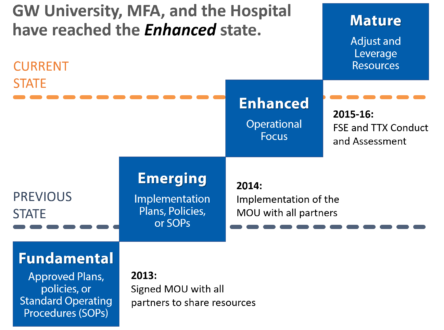Unified planning improves university security
A shared understanding of protocols, procedures, and terminology helped The George Washington University develop a collaborative and decisive crisis response program.
The largest institution of higher education in Washington, D.C., The George Washington University (GW) has over 26,000 students, more than 1,500 faculty, and large numbers of personnel and visitors who all depend on the university to provide a safe and secure environment. The GW Division of Safety and Security’s responsibilities include emergency preparedness, response and recovery efforts, law enforcement, and occupational and environmental health.
Challenge: Coordinating All the Players When Security is Paramount
Universities are under increasing stress to keep their communities safe as the environment of threats, hazards, social pressures, and regulation becomes more complex. The security of GW’s campuses, students, faculty, and staff is a shared priority across all university departments and units. GW sought Cadmus’ assistance to enhance coordination in how three partner organizations- the university, the GW University Hospital, and the GW medical faculty-manage incident response, strategic communications, and critical decision-making in response to protests, civil unrest, and acts of violence on the university’s Washington, D.C., campus.
Solution: A Formal Resilience Program
Universities can mitigate many potential threats with a formal resilience program. Cadmus helped GW create a more unified, efficient, and robust preparedness and response plan by identifying and addressing the following priorities:
- Internal and External Communications
- Effective Messaging
- Senior Leader Decision-Making
- Implementation of Protective Measures
- Alert Systems
- Resource Management

Figure adapted from the Department of Homeland Security 2016 National Preparedness Report
Result: Unity of Effort Creates a Safe and Secure Campus
As a result, GW improved its coordination and unity of effort across the university, both in its safety and security preparedness and in its activities during an emergency. These three key outcomes prepared the university to provide a safe and secure environment for its students, faculty, and staff members:
More Effective Decision-Making. The university took steps to enhance coordination between the three GW partner organizations to better deliver the efficient and effective implementation of incident management protocols and procedures.
Enhanced Joint Communications and Messaging. The university aligned its communication systems and strategies and improved its ability to manage, report, analyze, and disseminate critical information to stakeholders and the public.
Improved Integration of Response Plans. The university confirmed and improved synchronization of all applicable emergency response plans, response terminology, and resource-sharing protocols.
Learn more about how we support our clients in Planning, Training, and Doctrine.